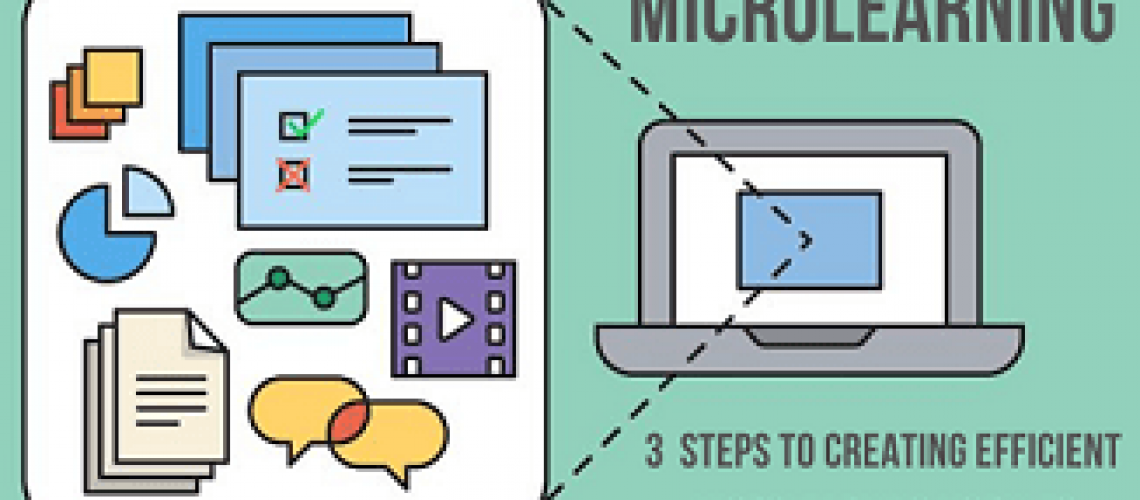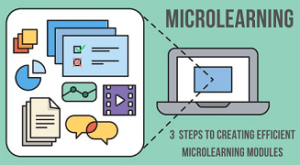Our article “Microlearning: The New Era of Bite-Sized eLearning to Optimize Retention” discussed what microlearning is and its benefits for businesses and learners. In this article, we go a little deeper by describing three steps for creating engaging microlearning course modules.
1. Start with the Big Picture (Focus on the Learning Objective)
The first step in developing microlearning content is to outline the big picture. Think of the learning objective, the one outcome your learners will achieve at the end of your bite-sized course. The identified goal should be achievable in a short period of time.
Understand in detail the goals of the organization or learner. A common mistake is to start with a small topic and build your content around it. This, however, is a faulty process as it might lead you to determine the wrong course size, or you might have issues coming up with other micro-learning topics.
Decide on the primary topic that you want to teach. Then, make a master list of all the subtopics related to the main topic. Include everything you would think about teaching. It is anyway better to have too much than too little here.
In the case of corporate training, talk to the managers and leadership team since they would have a better idea of the overall goals of the organization. Squeeze the maximum information out of them and then direct the inputs towards designing the outline of your microlearning modules efficiently.
Create a storyboard of your content to lay out the forms of communication. This stage of designing the course will also answer the important questions like —will the teaching take place on only one platform? Will there be a dedicated app for it? What platforms need to be designed for the course?
The set learning objective will act as the base of the pyramid upon which all the other pieces of the course programme will fall into place.
2. Make use of Visuals, Gamification, and Sound
Training retention and visuals are positively linked to each other. In a digital-heavy world, there are a wealth of visuals that you can include in a training module.
Have you ever come across someone not excited about animations? Right! Animations pique one’s interest immediately and keep the learners invested in the learning process.
Infographics are another powerful visual form that combines text, imagery, and illustrations to create comprehensive and impressive stories.
Videos are another excellent way to design microlearning modules and provide a sense of realism and familiarity that resonates with learners. Make sure that the length of videos is at most ten minutes, but best if the modules are 3 min or less to make the most of the benefits of microlearning.
Research studies have pointed towards the increased involvement of learners when the training course includes challenges or achievement milestones. People want to perform better than others or beat their previous scores to feel satisfied with their performances. Gamification leverages our intrinsic needs for validation, competence and reward. Interactive learning is the next big thing in eLearning and gamification is one of its essential elements. Bonus points if you can sneak in a leaderboard.
Moving away from traditional text and ever-relevant visuals, many creators consider the effective use of audio to be a game-changer when creating efficient microlearning modules. Don’t use too many overlapping voice-overs, but use an interesting background instead. Audio works best when it intelligently supports the visuals without overpowering them.
Also, podcasts, with their ability to be immersive, are another format that integrates well with micro-learning modules. Using different voice tones adapted to the course content is an excellent strategy to sustain learners’ interests.
By using visuals and podcasts, businesses can make their training courses easier to understand, absorb and recall valuable course content at the right time.
3. Take feedback and Improve
Consider that things may not pan out as expected even with diligent research and preparation. What works in your prototype might fall flat during the actual learning process. So with this in mind, don’t stop the Instructional Design/User Experience process at launch; rather, it’s an ongoing process for improvement. You should regularly review every training module to identify areas that need improvement or updates. Prepare a feedback guideline to track the success of the microlearning sessions.
The guideline might cover these aspects:
- Direct feedback from the learners.
- The number of employees who participated in the course.
- Were there one or more drop-off points? If yes, then when and why?
- Completion rate of the course?
- Correlation between the skills learned and on-the-job improvements.
Critical examination of these guidelines will help you develop a plan to increase the learners’ engagement, knowledge retention and application. The more often the solutions are based on real-time feedback, the better the output will be for both the learners and the course developer.
Wrapping It Up
Be assured that microlearning isn’t just slicing and dicing. Successful implementation needs detailed planning and careful strategizing.
With the cost-effectiveness, higher speed of development, and a multitude of benefits from the learner’s perspective, we already see the rapid adoption of microlearning. In addition, Millennials and Gen Z, who now make up a significant share of the workforce in their digitally-lived worlds, look for learning opportunities corresponding to their habits and needs, making microlearning a perfect fit and a win-win for all the stakeholders involved.




